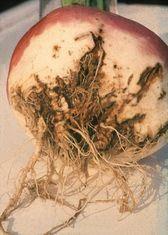
During the last 90 years, many entomologists have suggested that it should be possible to biologically control field populations of the cabbage root fly by releasing the small (2 to 4.5 mm long) parasitoid rove beetle Aleochara bilineata. However, to date, no one has used this, or any other beetle, successfully in this way.
Aleochara shows promise because its larvae destroy fly pupae (a pupa is the equivalent of a butterfly chrysalis) and because the adult beetles are voracious predators. Another advantage of using Aleochara is that it is a species native to the UK and so, if released into the field, it is unlikely to upset the ecological balance.
Adult Aleochara find the fly maggots by detecting the specific chemicals released when the maggots feed on plant roots. The beetles also lay their eggs in the soil alongside the feeding fly maggots. When these eggs hatch, the small Aleochara larva searches through the soil for a fly pupa and when it finds one it chews its way in and feeds on the developing fly. The Aleochara larva does not co-exist with the fly but actually kills it. Because of this it is called a parasitoid rather than a parasite.
Different types of parasitoids, mainly small wasps, kill the eggs, larvae and pupae of various insects. Unfortunately, the larvae of Aleochara kill only the pupal stage of the cabbage root fly. Hence, they act too late in the life-cycle of the fly to prevent direct crop damage. Their benefit as biological control agents is indirect, in that they reduce the numbers of flies that enter the next generation.
Many of the suggested ways of using Aleochara to control cabbage root fly in the field are based on the fact that laboratory tests have shown that each adult beetle can eat up to 60 fly eggs per day. Therefore, it was suggested that beetles should be released into brassica crops at the time the pest fly starts to lay eggs. However, experiments at Warwick HRI have shown that Aleochara eat only those eggs that are on the soil surface and, as most female cabbage root flies push their eggs into the soil, only a few eggs are available to predatory beetles. It seems that earlier researchers over-estimated the effectiveness of Aleochara as an egg predator.
However, as the adult Aleochara beetles also eat fly maggots, it is still possible that Aleochara could be used to reduce maggot damage in leafy brassica crops, in which some root damage can be tolerated.
Field experiments were done at Warwick HRI to test whether releasing Aleochara into leafy brassica crops could actually ‘control’ cabbage root fly. The experiments showed that each released beetle killed between two to five fly maggots.
The results also highlighted several difficulties associated with this type of biological control in the field. Firstly, to destroy the fly maggots successfully, the Aleochara have to be released at a specific time in the life-cycle of the pest. If the beetles are released too early, the fly will still be in the egg/early maggot stage and hence will be too young to produce the chemicals that arrest the adult Aleochara.
When this occurs the beetles simply fly out of the Brassica fields in which they were released. If the beetles are released too late, the result is obvious, the maggots will already have done unacceptable damage to the crop. While Aleochara under laboratory conditions will feed solely on fly maggots to mature its own eggs, under field conditions Aleochara also feeds on other small invertebrates.
Hence, releasing Aleochara earlier than it would occur naturally in the life-cycle of the fly, could also have an adverse effect on some of the other invertebrates thought to be important in the natural control of the cabbage root fly.
In addition, although each beetle can kill between two to five fly maggots, individual plants are often infested with more than 50 maggots. Hence, Aleochara will have to be released in high numbers to control high maggot populations.
Therefore, producing sufficient beetles at an economic cost is obviously a major constraint. It is not the only one, however, as although we can predict the time of year that cabbage root flies enter crops, we cannot predict how many flies will enter each crop.
Therefore, even with sufficient beetles, there is no way of knowing the optimum numbers to release into each field, unless fly numbers are monitored on a regular basis. Furthermore, to be effective the beetles may have to be released at regular intervals over a protracted period of time.
Obviously, the logistics involved in the production of beetles for such an approach are likely to be both difficult and expensive. Finally the situation under field conditions is even more complex than we thought originally, as the relative effectiveness of the beetles also changes from crop to crop, from field to field and from year to year.
This research was funded by Defra



